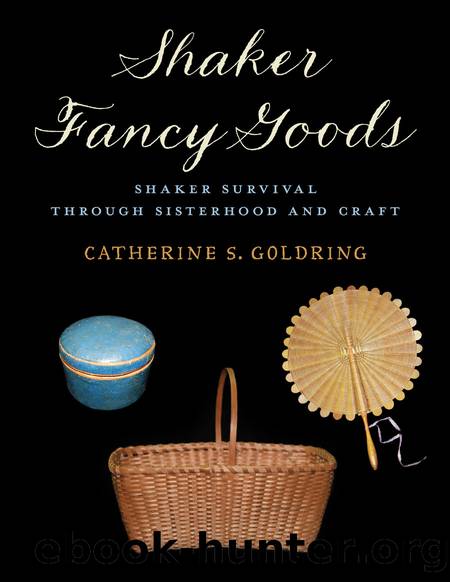Shaker Fancy Goods by Catherine S. Goldring

Author:Catherine S. Goldring
Language: eng
Format: epub
Publisher: Down East Books
Published: 2022-05-17T00:00:00+00:00
FINAL DAYS OF SHAKER CLOAK SALES
THE CLOAK INDUSTRY faded from prominence after 1930. Why this happened has never been entirely clear, but womenâs styles had changed dramatically since the era of the Shaker cloakâs greatest popularity at the turn of the century. As noted earlier, since 1915, sales suffered a gradual but steady decline. In part, this must have been a reaction to changing styles of dress during these crucial years of the First World War, the womenâs suffrage movement, and finally the Great Depression of October 1929. The drop-waisted, loose fitting flapper dresses of the twenties had given way to the trimmer, high-waisted, longer dresses and fitted coats of the thirties, when trousers for certain pastimes were considered commeilfautâ proper or acceptable for women. The âliberated womanâ of the thirties was less likely to want to be hampered by a cloak swirling around her ankles, restricting freedom of movement with an excess of cloth, and not nearly so practical as a coat for keeping out the weather. Eveningwear for the well-heeled fashion-conscious woman then included fur-embellished coats, stoles, wraps, and accessories.
Another factor for many was that money was tight in these years, when it was more common for a woman to remake old clothes than it was for her to buy new. Meanwhile, ânewâ to the clothing industry in the early days of mass production, as today, meant ready-to-wear, and not just for the woman on a budget.
Still, sources reveal an enduring, though far scarcer, enthusiastic following for Shaker cloaks into the mid-twentieth century. In 1930, for example, a note in the Canterbury records reads: âJan. 7 M.A. Wilson [Eldress Mary Ann] and B.L. Phelps [Sister Bertha Lillian] to Florida and other southern resorts to sell cloaks and fancy goods. Home April 6th.â In November 1933, we find this description presumably concerning a cloak made to order: âBlack Dorothy cloak lined entirely with purple satin $36.00.â 42 More poignant, as late as 1948, a letter from the Canterbury Shakers confirms the shipment of two childrenâs cloaks to a customer: â. . . today Parcel Post Ins. a childâs cloak in red, and a baby cape, to complete the samples previously sent to you. Trust they will be satisfactory in every way,â followed by this pointed reference to marketing the cloaks: âWe appreciate your kindness in trying to help us to a market for our work.â43
By mid-century, a Shaker cloak was a treasured possession whose provenance was meticulously recorded and updated as the cloak changed hands several times before finding its way into a museum or private collection. For instance, the âbeautiful medium dark red cloakâ with a hood lined in purplish-red silk made before 1917 by Sister Emma J. Neale of Mount Lebanon for a Mrs. Cheeney of Pittsfield, Massachusetts, was subsequently purchased in 1955 from a woman in Ohio who had in turn bought it from Sister Jennie Wells, of Hancock Shaker Village. The cloak, as noted on the accession card at the Shaker Museum in Mount Lebanon, was âin fine conditionâ but for a few moth holes.
Download
This site does not store any files on its server. We only index and link to content provided by other sites. Please contact the content providers to delete copyright contents if any and email us, we'll remove relevant links or contents immediately.
| Anglican | Baptist |
| Book of Common Prayer | Calvinist |
| Episcopalian | Inspirational |
| Lutheran | Methodist |
| Pentecostal & Charismatic | Presbyterian |
| Quaker | Seventh-Day Adventist |
| Shaker | Theology |
Angels by Billy Graham(1886)
How To Be Born Again by Billy Graham(1730)
Peace with God by Billy Graham(1642)
Unbroken Curses by Rebecca Brown & Daniel Yoder(1518)
God's Prophetic Symbolism in Everyday Life by Adam Thompson & Adrian Beale(1446)
The School of Biblical Evangelism by Ray Comfort(1389)
Call by Rick Joyner(1362)
Martin Luther: The Man Who Rediscovered God and Changed the World by Eric Metaxas(1352)
Power over the Enemy by John Osteen & Joel Osteen(1315)
Jonathan Edwards: A Life by Marsden George M(1193)
Fresh Wind, Fresh Fire by Jim Cymbala(1190)
Prayers That Bring Healing and Activate Blessings: Experience the Protection, Power, and Favor of God by John Eckhardt(1185)
Liturgy of the Ordinary by Tish Harrison Warren(1182)
The Supernatural Power of a Transformed Mind Expanded Edition: Access to a Life of Miracles by Bill Johnson(1172)
Unmasking the Devil: Strategies to Defeat Eternity's Greatest Enemy by John Ramirez(1161)
An Altar in the World by Barbara Brown Taylor(1152)
Reformation Theology by Littlejohn Bradford(1146)
Martin Luther by Mansch Larry D.; Peters Curtis H.;(1102)
Seeing the Voice of God: What God Is Telling You through Dreams and Visions by Smith Laura Harris(1101)
